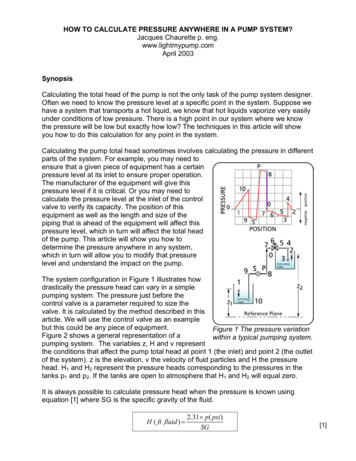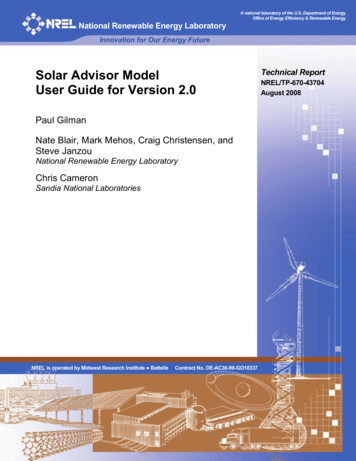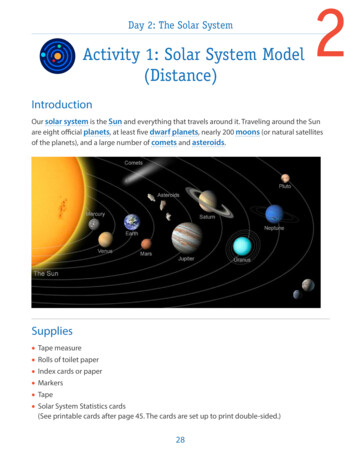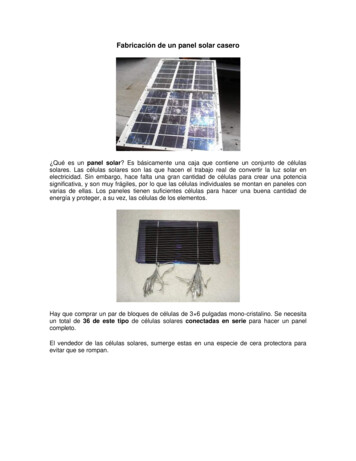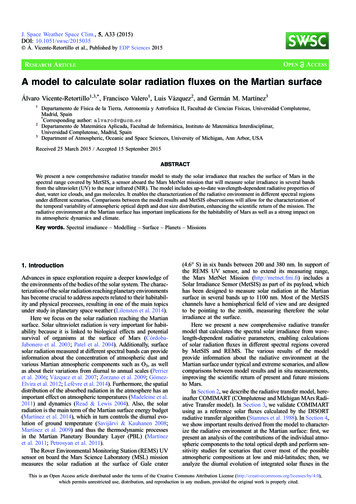
Transcription
J. Space Weather Space Clim., 5, A33 (2015)DOI: 10.1051/swsc/2015035Ó Á. Vicente-Retortillo et al., Published by EDP Sciences 2015OPENRESEARCH ARTICLEACCESSA model to calculate solar radiation fluxes on the Martian surfaceÁlvaro Vicente-Retortillo1,3,*, Francisco Valero1, Luis Vázquez2, and Germán M. Martínez3123Departamento de Física de la Tierra, Astronomía y Astrofísica II, Facultad de Ciencias Físicas, Universidad Complutense,Madrid, Spain*Corresponding author: alvarodv@ucm.esDepartamento de Matemática Aplicada, Facultad de Informática, Instituto de Matemática Interdisciplinar,Universidad Complutense, Madrid, SpainDepartment of Atmospheric, Oceanic and Space Sciences, University of Michigan, Ann Arbor, USAReceived 25 March 2015 / Accepted 15 September 2015ABSTRACTWe present a new comprehensive radiative transfer model to study the solar irradiance that reaches the surface of Mars in thespectral range covered by MetSIS, a sensor aboard the Mars MetNet mission that will measure solar irradiance in several bandsfrom the ultraviolet (UV) to the near infrared (NIR). The model includes up-to-date wavelength-dependent radiative properties ofdust, water ice clouds, and gas molecules. It enables the characterization of the radiative environment in different spectral regionsunder different scenarios. Comparisons between the model results and MetSIS observations will allow for the characterization ofthe temporal variability of atmospheric optical depth and dust size distribution, enhancing the scientific return of the mission. Theradiative environment at the Martian surface has important implications for the habitability of Mars as well as a strong impact onits atmospheric dynamics and climate.Key words. Spectral irradiance – Modelling – Surface – Planets – Missions1. IntroductionAdvances in space exploration require a deeper knowledge ofthe environments of the bodies of the solar system. The characterization of the solar radiation reaching planetary environmentshas become crucial to address aspects related to their habitability and physical processes, resulting in one of the main topicsunder study in planetary space weather (Lilensten et al. 2014).Here we focus on the solar radiation reaching the Martiansurface. Solar ultraviolet radiation is very important for habitability because it is linked to biological effects and potentialsurvival of organisms at the surface of Mars (CórdobaJabonero et al. 2003; Patel et al. 2004). Additionally, surfacesolar radiation measured at different spectral bands can provideinformation about the concentration of atmospheric dust andvarious Martian atmospheric components such as O3, as wellas about their variations from diurnal to annual scales (Perrieret al. 2006; Vázquez et al. 2007; Zorzano et al. 2009; GómezElvira et al. 2012; Lefèvre et al. 2014). Furthermore, the spatialdistribution of the absorbed radiation in the atmosphere has animportant effect on atmospheric temperatures (Madeleine et al.2011) and dynamics (Read & Lewis 2004). Also, the solarradiation is the main term of the Martian surface energy budget(Martínez et al. 2014), which in turn controls the diurnal evolution of ground temperature (Savijärvi & Kauhanen 2008;Martínez et al. 2009) and thus the thermodynamic processesin the Martian Planetary Boundary Layer (PBL) (Martínezet al. 2011; Petrosyan et al. 2011).The Rover Environmental Monitoring Station (REMS) UVsensor on board the Mars Science Laboratory (MSL) missionmeasures the solar radiation at the surface of Gale crater(4.6 S) in six bands between 200 and 380 nm. In support ofthe REMS UV sensor, and to extend its measuring range,the Mars MetNet Mission (http://metnet.fmi.fi) includes aSolar Irradiance Sensor (MetSIS) as part of its payload, whichhas been designed to measure solar radiation at the Martiansurface in several bands up to 1100 nm. Most of the MetSISchannels have a hemispherical field of view and are designedto be pointing to the zenith, measuring therefore the solarirradiance at the surface.Here we present a new comprehensive radiative transfermodel that calculates the spectral solar irradiance from wavelength-dependent radiative parameters, enabling calculationsof solar radiation fluxes in different spectral regions coveredby MetSIS and REMS. The various results of the modelprovide information about the radiative environment at theMartian surface under typical and extreme scenarios, and allowcomparisons between model results and in situ measurements,improving the scientific return of present and future missionsto Mars.In Section 2, we describe the radiative transfer model, hereinafter COMIMART (COmplutense and MIchigan MArs Radiative Transfer model). In Section 3, we validate COMIMARTusing as a reference solar fluxes calculated by the DISORTradiative transfer algorithm (Stamnes et al. 1988). In Section 4,we show important results derived from the model to characterize the radiative environment at the Martian surface: first, wepresent an analysis of the contributions of the individual atmospheric components to the total optical depth and perform sensitivity studies for scenarios that cover most of the possibleatmospheric compositions at low and mid-latitudes; then, weanalyze the diurnal evolution of integrated solar fluxes in theThis is an Open Access article distributed under the terms of the Creative Commons Attribution License (http://creativecommons.org/licenses/by/4.0),which permits unrestricted use, distribution, and reproduction in any medium, provided the original work is properly cited.
J. Space Weather Space Clim., 5, A33 (2015)MetSIS band 200–1100 nm under different scenarios and compare them with fluxes calculated in the full shortwave spectralrange; finally, we study spectral irradiances in the range200–1100 nm also under different scenarios, and describe amethod to estimate the optical depth and particle size distribution from the model and in situ measurements in differentbands. In Section 5, we summarize our results and discuss theirimportance.from the individual contributions of each atmosphericcomponent assðkÞ ¼ sg ðkÞ þ sd ðkÞ þ sc ðkÞ:ð2ÞThe optical depth of each component can be separated intotwo terms: one accounting for scattering (indicated with thesubscript s) and the other for absorption (denoted with the subscript a). Following this notation, Eq. (2) can be rewritten assðkÞ ¼ sgs ðkÞ þ sds ðkÞ þ scs ðkÞ þ sga ðkÞ þ sda ðkÞ2. Description of the modelþ sca ðkÞ:The solar radiation at the top of the atmosphere (TOA) and theradiative properties of the atmosphere govern the solar flux thatreaches the surface of Mars. The calculation of the solar radiation at the TOA and the determination of the radiativeproperties of the Martian atmosphere based on updated wavelength-dependent radiative properties of its components aredescribed below.2.1. Solar spectrum at the top of the atmosphereThe spectral irradiance that reaches a horizontal surface at theTOA as a function of the latitude and time of the year can bedetermined using the expression 1 2E ¼ Em sin e sin Ls sin / þ 1 sin2 e sin2 Ls 2 2pt 1 þ e cos Ls Ls;p cos / cos; ð1ÞP1 e2where Em represents the spectral irradiance at the meandistance between the Sun and Mars (1.52 AU), e 0.0934is the eccentricity of the orbit of Mars, Ls,p 251 is thesolar longitude at the perihelion, e 25.2 is the Martianobliquity, P 88,775 s is the length of a sol (a Martianday), / is the latitude, and t is the time measured in secondsfrom local noon (Haberle et al. 1993; Patel et al. 2002).In COMIMART, Em is determined from the 2000 AmericanSociety for Testing and Materials (ASTM) Standard Extraterrestrial Solar Spectrum Reference E-490-00 (http://rredc.nrel.gov/solar/spectra/am0).The first bracket on the right-hand side of Eq. (1) represents the cosine of the solar zenith angle, while the secondone shows the ratio of the mean distance between the Sunand Mars to the distance at a given orbital position. By usingEq. (1) we are assuming that the Sun is a point source, a standard approximation for radiative transfer studies on the Earthdue to the small errors involved except during sunrise or sunset(Stamnes et al. 2000), which become even smaller for Marsdue to the larger distance to the Sun.2.2. Radiative properties of the Martian atmosphereThe different components of the Martian atmosphere interactwith the solar radiation by means of absorption and scatteringprocesses. The components considered in this model are dust,water ice clouds, and gas molecules (CO2, N2, Ar, O2, O3, andH2O). These components are denoted with the subscripts d, c,and g.In order to obtain the amount of radiation that reachesthe surface, the total atmospheric optical depth s is calculatedð3ÞA description of the calculation of the terms of Eq. (3) isprovided below, beginning with dust, continuing with clouds,and ending with the terms related to the gas molecules.Among the various Martian atmospheric constituents, dusthas the greatest impact on the absorption and scattering ofsolar radiation. In order to quantify the result of its interactionwith solar radiation, three radiative parameters are needed: theextinction efficiency, Qext,d(k), defined as the extinction crosssection (the sum of the scattering and absorption crosssections) divided by the projected surface area of the sphericalparticle; the single scattering albedo, x0,d(k), defined as theratio between scattering and extinction coefficients; and theasymmetry factor, gd(k), defined as the first moment of thephase function, which represents the probability of scatteringin any given direction.In COMIMART, we calculate updated wavelengthdependent values of these three parameters by using the Mietheory and the refractive indices presented by Wolff et al.(2009) and Wolff et al. (2010). These three parameters alsodepend on the size distribution of the particles. Here weassume a log-normal size distribution, characterized by theeffective radius, reff, and the effective variance, meff (Hansen& Travis 1974), and select standard values of reff 1.5 lm(Clancy et al. 2003; Wolff & Clancy, 2003; Kahre et al.2006; Madeleine et al. 2011) and meff 0.3 (Rannou et al.2006; Madeleine et al. 2011). The reader is referred toSection 4.3 for a discussion of the impact of choosing differentsize distributions on the calculation of the spectral irradiance.Madeleine et al. (2011) show that the opacity of the atmosphere is directly proportional to the extinction efficiency.Thus, by using the value of the optical depth at any particularwavelength as a reference, we calculate the dust opacity sd(k)at any other wavelength from the corresponding value ofQext,d(k). We have chosen 880 nm as a reference inCOMIMART to enable a direct comparison to the measurements taken by the Pancam cameras at the locations of theMars Exploration Rovers (Lemmon et al. 2015) and by theMastcam cameras at the MSL site; we denote the dust opticaldepth at this wavelength by sd,880. The model enables the calculation of the two contributions (scattering and absorption) tosd. The scattering optical depth due to dust particles in Eq. (3)is obtained by multiplying sd(k) by x0,d(k).Solar radiation also interacts with water ice clouds. In orderto quantify their effect, we calculate the water ice radiativeproperties (Qext,c(k), x0,c(k), and gc(k)) from the refractiveindices given by Warren (1984). In this case, we select alog-normal size distribution with reff 3 lm (Wolff & Clancy2003) and meff 0.1 (Wolff & Clancy 2003; Madeleine et al.2012). In order to obtain sc(k), we follow the same procedureas for the dust, but selecting 825 cm 1 (roughly 12.1 lm) asA33-p2
Á. Vicente-Retortillo et al.: Modeling solar radiation fluxes on Marsthe reference wavelength to simplify the comparison toThermal Emission Spectrometer (TES) results (Smith 2004).Thus, we obtain sc(k) ass c ð kÞ ¼Qext;c ðkÞsca;12:1 ;Qext;c;12:1 ð1 x0;c12:1 Þð4Þwhere sca,12.1 stands for the TES absorption optical depth.We have followed the same scheme as in the dust case to calculate the absorption and scattering cloud optical depths ateach wavelength.The interaction of gas molecules with solar radiation isquantified by means of their scattering and absorption crosssections. The total optical depth due to scattering by gas molecules is given by the sum of the scattering optical depths ofCO2, N2, Ar, and O2, which are calculated multiplying theircolumn abundance N by their Rayleigh scattering cross-sectionrs as followssgs ¼ rs;CO2 N CO2 þ rs;N2 N N2 þ rs;Ar N Ar þ rs;O2 N O2 :ð5ÞNote that scattering by O3 and H2O is not consideredbecause these molecules are variable trace species in theMartian atmosphere, and thus we can consider their effect onRayleigh scattering negligible. The column abundance isobtained using the expressionN¼p Avnrel ;M g ð6Þwhere p represents the pressure at the surface, Av is theAvogadro’s number, M is the molecular mass of the gas, g*is the gravity, and nrel is the relative abundance of the gasin the atmosphere. The scattering cross-section is obtained as 224p3 n2 ðkÞ 1F k ðkÞ;ð7Þrs ðkÞ ¼ 2 2 2k N s n ðkÞ þ 2where Ns represents the number of molecules per unit of volume, n is the refractive index, and Fk is the King correctionfactor (Sneep & Ubachs 2005). Refractive indices for CO2and O2 are taken from Sneep & Ubachs (2005), while forN2 and Ar they are taken from Weber (2003) and referencesherein. King correction factors for CO2, O2, N2, and Ar aretaken from Sneep & Ubachs (2005).Absorption by gas molecules is calculated from theirabsorption cross-sections when an absorption continuum isobserved for a particular component. In addition to the absorption continua, some gas molecules of the Martian atmosphere,especially CO2 and H2O, show absorption lines that can becharacterized individually in the shortwave range (Rothmanet al. 2013). We have not included these lines in the modelbecause they have a negligible effect in the 200–1100 nmrange, and st
A model to calculate solar radiation fluxes on the Martian surface Álvaro Vicente-Retortillo1,3,*, Francisco Valero1, Luis Vázquez2, and Germán M. Martínez3 1 Departamento de Física de la Tierra, Astronomía y Astrofísica II, Facultad de Ciencias Físicas, Universidad Complutense, Madrid, Spain *Corresponding author: alvarodv@ucm.es 2 Departamento de Matemática Aplicada, Facultad de .



